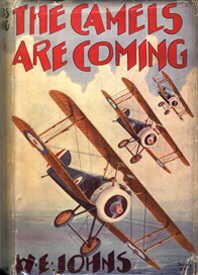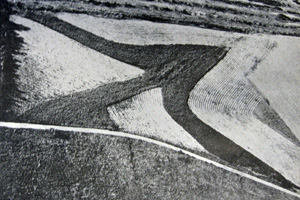Some perfectly ordinary banter, c. 1917:
First “Hun”: “Did you see old Cole’s zoom on a quirk this morning?”
Second “Hun”: “No, what happened?”
First “Hun”: “Oh, nothing to write home about … stalled his ‘bus and pancaked thirty feet … crashed completely … put a vertical gust up me … just as I was starting my solo flip in a rumpty!”
This is the start of an article by W. A. B. entitled ‘Airmen in the making’, from the Daily Mail, 19 July 1917, p. 4. It’s about some of the new words and phrases used by trainee RFC pilots: ‘no one can claim so many strikingly original terms as the air services’. Most of the examples given weren’t actually new; some of them don’t seem to have survived the war; others are still familiar enough in an aviation context; and yet others are now so widely used that their aeronautical context comes as a surprise.
Hun does not here refer to one of Biggles’ foes but to the trainee pilots themselves. The OED’s earliest cite for this sense is 1916; a later cite from 1925 suggests that the derivation was that flight cadets tended to be highly destructive of training aircraft. Zoom (a ‘soul-satisfying word’) is what an aeroplane does when it is ‘hauled up apruptly and made to climb for a few moments at a dangerously sharp angle’. But it seems that zooming was already something that moving objects did, especially if they made some sort of humming or other sound as they did so: an OED cite from 1904 has bees zooming against a window plane. All sorts of vehicles can zoom these days, though aircraft may have been first. But we probably use it more often to refer to cameras or image editing software. A quirk is a training aeroplane (though according to the OED it can also mean a trainee pilot), or just any which is slow and ungainly. But it’s a very old word, in the sense of something odd or unusual, which seems directly related to this usage. A rumpty is a specific type of training aeroplane, namely a Maurice Farman Shorthorn. According to the RAAF Museum, it (or rather Rumpety) is an onomatopoeic word, from the sound it makes while travelling over the ground.
To stall in the aeronautical sense is of course quite familiar, but stalling in the sense of coming to a standstill is quite old (OED’s first cite is c. 1460). ‘Bus is short for omnibus, presumably — a later generation of pilots might have said kite or ship. To pancake I had previously understood just to mean to land, but it can evidently also mean a sudden vertical drop (i.e. from a stall) or a crash. A solo flip is a solo flight — does anyone take a flip anymore? And finally, a vertical gust sounds like a straightforward meteorological term, but in this context it’s a ‘breezy way’ for the Hun to confess that seeing the crash before his own solo had, well, put the wind up him.
The other words in the article are still standard aviation terms, though to gamers of a certain age a joystick doesn’t necessarily have anything to do with even simulated flight. W. A. B. ends by claiming gadget for the airmen:
But the most priceless word of all is “gadget.” If the name of anything escapes you call it a “gadget” and you will be understood!
And it is indeed an excellent word. But sadly for the RFC’s legacy, the OED shows that sailors were using it three decades earlier: ‘if the exact name of anything they want happens to slip from their memory, they call it a chicken~fixing, or a gadjet, or a gill-guy, or a timmey-noggy, or a wim-wom’. Though perhaps we can thank the airmen for choosing to bring gadget into common use instead of chicken~fixing! (And just how do you pronounce ~ anyway?)
![]() This work is licensed under a Creative Commons Attribution-NonCommercial-NoDerivatives 4.0 International License.
Permissions beyond the scope of this license may be available at http://airminded.org/copyright/.
This work is licensed under a Creative Commons Attribution-NonCommercial-NoDerivatives 4.0 International License.
Permissions beyond the scope of this license may be available at http://airminded.org/copyright/.





Tilde. So it’s a chicken-tilde-fixing, clearly, in order to be unambiguous to a typesetter. (Any mechanical device which fixes a chicken to Tilde has got to be pretty bizarre…)
More seriously, maybe it’s not a tilde, but a swung dash as a mark of omission – in which case the OED’s source may have delicately glossed over a properly nautical obscenity, perhaps?
Speaking of which, that chicken-*******-fixing device otherwise known as my computer has THREE TIMES NOW thrown away my attempt to comment further on bomb shelters and construction dates. Short answer: sorry, no evidence on mine. It sounds like a superb measure, but probably a very difficult one to study now most private shelter builders have moved or died. Maybe Mass Observation or the building industry’s trade press might provide clues as to waves of private shelter construction? If only there were a large body of searchable private diaries…
“Tilde.” It’s called a “tilde.”
I never stop being helpful.
A pancake is when you come in at the perfect speed for a landing run, and settle onto your landing gear –and it turns out you were still a few feet of the ground. Oops. As a fairly common form of accident, it does show why landing gear design was so much more complicated than it seems.
Lester:
Swung dash, could be!
Thanks for the attempted posts … it’s just an idea for the back-burner.
The Bus may be a reference to the Vickers FB5, known as the Vickers Gunbus, the world’s first purpose-built fighter.
Interestingly, the nickname survives to this day; the VC-10 is known as the Vickers Funbus.
I did think of that, but the FB5 went out of active service in 1916. Maybe it was still being used for training? ‘Bus also could have been retained as a generic name, I suppose.
Wikipedia: The F.B.5’s performance proved to be inadequate for its intended role; although its forward firing machine gun was a great advantage, the fighter did not have the speed or rate of climb to pursue its quarry. By the end of 1915 it was outclassed by the Fokker Eindecker. Some examples of the improved Vickers F.B.9 were sent to France, pending sufficient supplies of the Royal Aircraft Factory F.E.2b, but the active career of the “Gunbus” was soon over. The remaining examples were mostly used as trainers.
They also mention 50 of the later FB9 being used as trainers.